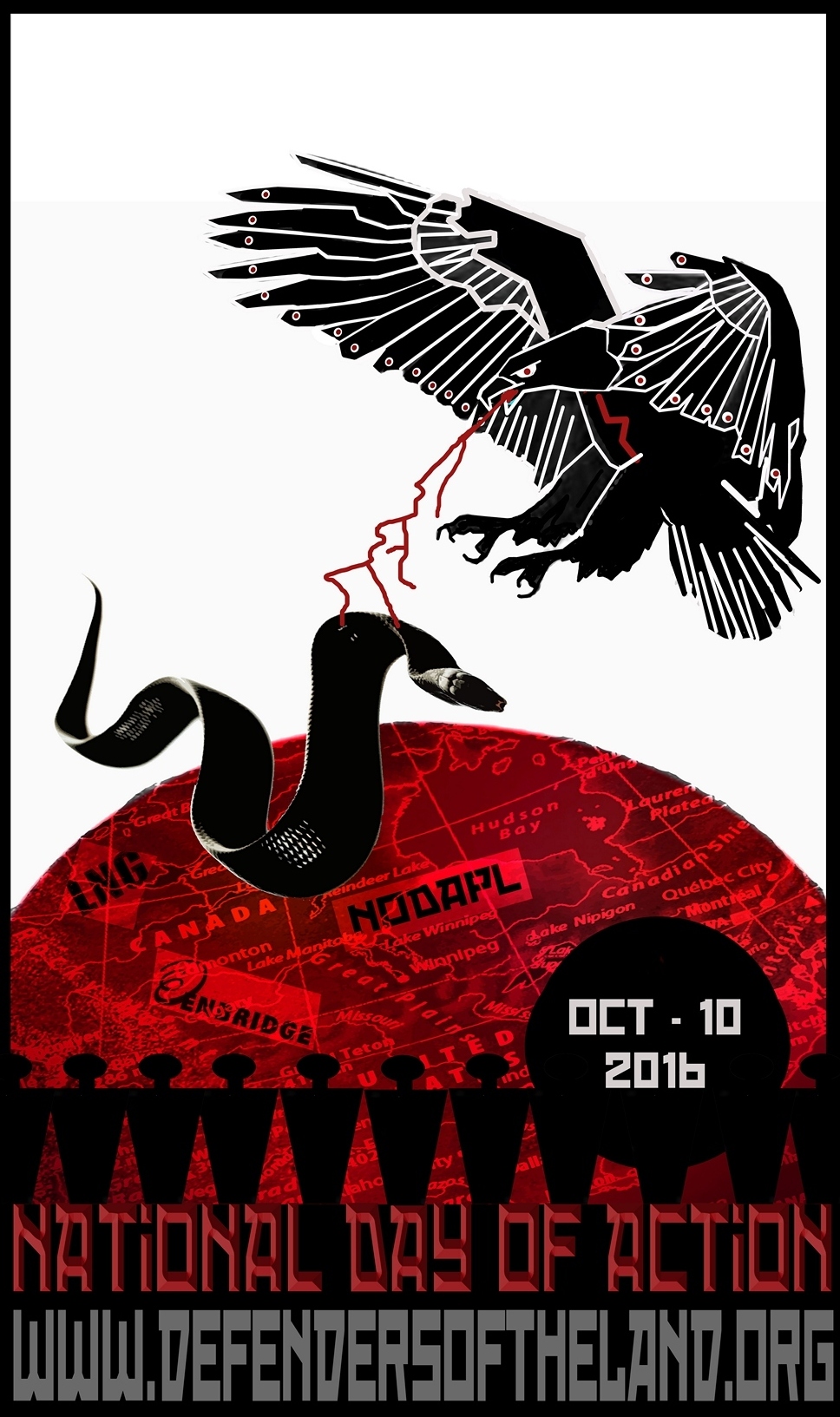
|
October 8, 2016 - No. 39 Sisters in Spirit
Vigils Affirm that Struggle
• Actions
Across the Country Demand Justice
Uphold Indigenous Rights! Sisters in Spirit Vigils Affirm that Struggle for
|
|
|
First Nations in Canada are waking up to the reality that the Trudeau government has a big smiley face for a front man, but when it comes to business, nothing has changed. This government approved the Site C mega-Dam in Treaty 8 (BC Peace River region), against the objection of First Nations whose lands will be devastated by flooding, destroying access to their food, medicines, and sacred sites. Just [on September 27], they approved the dangerous and climate-destroying Lelu Island Liquid Natural Gas plant against the wishes of local First Nations. Now under review in Alberta by a system that has never denied a tar sands mine is the Teck Frontier tar sands mine, which would be the largest ever. The federal government, which campaigned on implementing the UN Declaration on the Rights of Indigenous Peoples [UNDRIP], has since informed chiefs from across Canada that adopting UNDRIP is unworkable. Now they have backtracked on their obligations under the Paris Climate Accord, too.
It is already clear what needs to be done. Canada needs a leader with political integrity and courage to do it. We demand that the Trudeau government take credible action to:
- Implement UNDRIP in Canadian law.
- Clearly indicate
it
respects Indigenous Peoples' right to say no to development on
their land. (This means Free, Prior, and Informed Consent, not
manipulated sham consultations.)
- Stop the Site C dam.
- Close the
funding deficit for First Nations now.
- Stop pipeline, gas, and
oil megaprojects: build green energy, transit, and houses.
Accordingly, this Thanksgiving, Indigenous communities
and
supporters will be conducting actions, holding ceremonies, and
gatherings across Canada to protect land and water and to demand
the Trudeau government stop pretending, and start acting like it
respects our rights. It is high time for deeds, not words. We ask
First Nations and allies on both sides of the medicine line, on
the land or in cities, to respond to this call by undertaking
action, in accordance with their own capacities,
responsibilities, and their protocols. To join us please email
indigenousdayofaction@gmail.com.
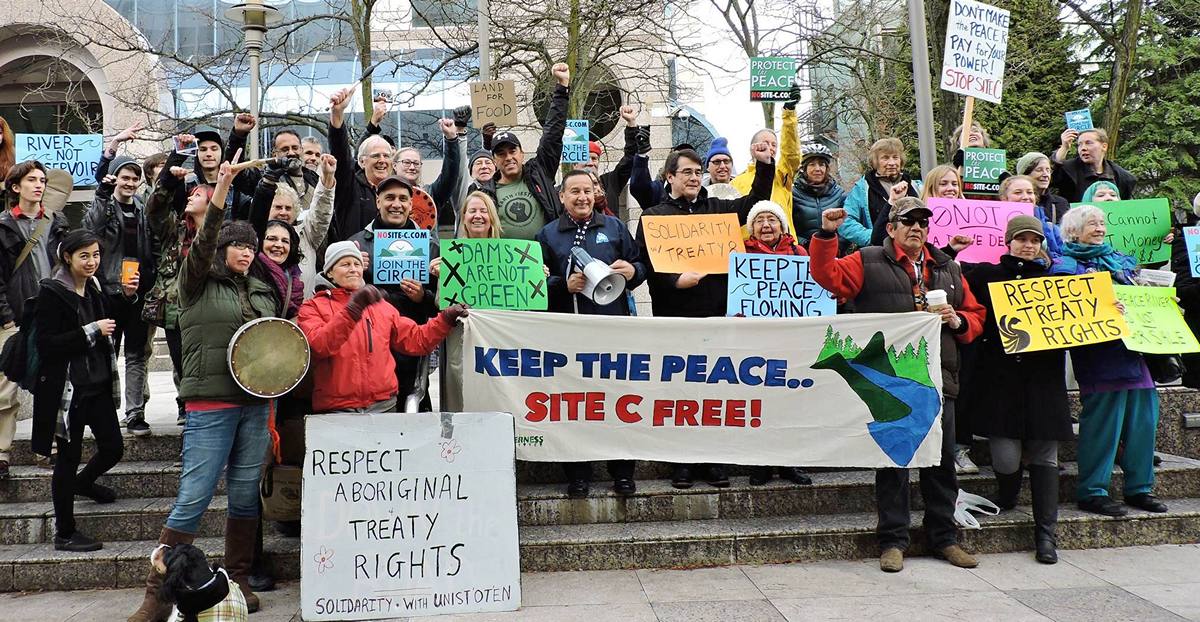
Vancouver protest against decision to proceed on Site C
Dam, February 2016.
Background
On matters of substance, this government is pursuing the same assimilation agenda as previous governments. There has been no change to the disastrous comprehensive claims policy. One hundred and fifty years of Canada trying to terminate and extinguish Indians has not worked. We are still here and we will still be here hundreds of years from now. Until Canada reckons with, recognizes, and respects Indigenous peoples' rights and title, and makes legitimate redress for past wrongs, there will be no lasting peace.
This government has still not committed to a plan to undo the deliberate cultural genocide that targeted Indigenous languages and traditions. No serious commitment to Indigenous language revitalization has been put forth. The important recommendations of the Truth and Reconciliation Commission and the Royal Commission on Aboriginal Peoples have been ignored.
 Optimists believed this
government would deliver more money
for programs and services. Yet the much vaunted spending
announcements of this government will not kick in for years, and
will still leave First Nations gasping, at poverty-level funding
below funding for the average Canadian, after decades of an
arbitrary 2 per cent funding cap that has scrimped First Nations
into a $60 billion funding gap. The lack of clean water, safe
housing, and adequate education, coupled with abusive government
and failure to redress the legacy of cultural genocide, have
produced a profound mental health and suicide epidemic in many
communities.
Optimists believed this
government would deliver more money
for programs and services. Yet the much vaunted spending
announcements of this government will not kick in for years, and
will still leave First Nations gasping, at poverty-level funding
below funding for the average Canadian, after decades of an
arbitrary 2 per cent funding cap that has scrimped First Nations
into a $60 billion funding gap. The lack of clean water, safe
housing, and adequate education, coupled with abusive government
and failure to redress the legacy of cultural genocide, have
produced a profound mental health and suicide epidemic in many
communities.
In the face of government indifference or hostility, Indigenous peoples across Canada and the United States have had to protect their waters and lands from abusive development that violates their duties to protect the land: from hydro dams at Site C in British Columbia; Keeyask in Manitoba, and Muskrat Dam in Labrador, Newfoundland to Mi'kmaq people and their allies in Stop Alton Gas protecting the waters of the Sipekne'katik district of the Mi'kmaq Nation; the Algonquins of Barriere Lake in their decades-long struggle for their rights against government abuse, now fighting a Copper One mine being developed on their territory without consent; Neskantaga First Nation, trying to stop Noront's Ring of Fire drilling on its land; and Indigenous peoples and allies fighting toxic, reckless pipeline and oil development in places like Aamjiwnaang, Kanehsatake, Unist'ot'en, Tsleil-Waututh, Secwepemc territory and Standing Rock, North Dakota. For legitimate defense of their rights, many Indigenous land and water protectors are criminalized or targeted with legal harassment and intimidation by big corporations, like Vanessa Gray of Aamjiwnaang, currently facing expensive court proceedings.
As part of this day of action, we call on Canada to take seriously its obligations under international law, the Canadian constitution, and the principles of justice, and once and for all reconcile itself to our continued existence on this land as Indigenous Peoples. The government has ignored the excellent recommendations of Commission after Commission. Will it ignore the recommendations of the Murdered and Missing Women and Girls Inquiry too? Now is the time for Deeds, not Words.
(September 28, 2016)
Neo-Liberal Assault on Health Care
Continues
Contradictions Sharpen Between Federal
Government and Provinces
The inter-governmental disputes over health care funding form part of the inter-monopoly struggle to enrich particular private interests. These disputes are not meant to solve problems of building a modern health care system but on the contrary are a symptom of a system in crisis.
The Trudeau government,
similar to the Harper government before it, having been elected as a
majority government, considers itself to have a mandate to act in the
interests of particular monopolies and serve their empire-building,
rather than in the interest of Canadians and modern nation-building. To
have an efficient modern health care system to meet the needs of all
Canadians without fail requires the restriction of monopoly right. The
existing monopolies in the health care sector must be deprived of their
monopoly right to impose their narrow aim on the sector to serve their
private interests. To meet and guarantee every Canadian's right to
comprehensive health care requires a modern health care system where
its specific aim and mandate is to guarantee the right of all to health
care -- no ifs, ands, or buts. The same is true of guaranteeing the
right to education for all. This forms a crucial part of the
nation-building project of the working class.
Inter-Governmental Feuding to Control Health Care Spending
When Dr. Jane Philpott, Minister of Health in the newly elected Liberal government met with provincial health ministers in January of this year, the issue of funding from the federal government to the provinces was raised by the provincial and territorial health ministers. This was the first federal/provincial meeting on health care since the unilateral declaration of the Harper government that there would be no renewal of the 2004-2014 Health Accord and that federal transfers would drop in 2017 from a guaranteed six per cent annual increase to funding tied to economic performance with a three per cent minimum. At the January 2016 meeting, Minister Philpott said that she did not want the discussion of funding to be a "distraction." In a press conference following the meeting, provincial health ministers announced that they would continue to raise the issue of funding at subsequent meetings.
During the 2015 federal election campaign, the Liberals committed to negotiating a new Health Accord with the provinces and territories, appearing to distance themselves from the Harper Conservative government's dictate. The funding reduction scheduled to come into effect in 2017 was estimated by the Parliamentary Budget Officer to represent a reduction of $36 billion in funding over the period 2014 to 2024. The 10-year Health Accord which was negotiated in 2003 included, besides the funding formula, commitments for national standards for home care, pharmacare, surgical wait lists and other matters, commitments that were in the main not met.
No further meetings of the health ministers have taken
place to discuss a new health accord since January. Provincial and
territorial first ministers sent a letter to Prime Minister Trudeau
after their July meeting in Whitehorse requesting a meeting with him,
specifically on the question of health care transfers from the federal
government.
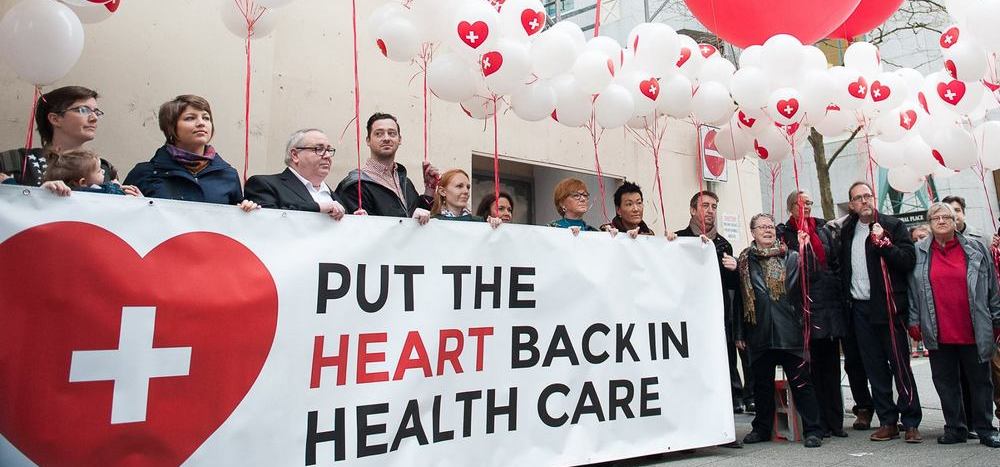
Protest outside Health Ministers' meeting in Vancouver, January 20,
2016. (HEU)
With 2017 fast approaching and along with it a decrease in federal funding for health care, provincial premiers sent their second letter to Trudeau on September 15, requesting a meeting with him before their meeting on Climate Change. If that were not possible, they asked for a commitment to hold off on implementing the health funding reduction for a year. On behalf of the premiers, Yukon Premier Darrell Pasloski wrote: "In the spirit of collaboration and to reflect the importance of this issue, we believe that this meeting should be confirmed prior to the first ministers' meeting on climate change and clean growth."
The dispute heated up on September 29 at the Canada 2020 Health Summit in Ottawa at which Minister Philpott and Quebec Minister of Health Gaetan Barrette were speakers. The conflict between the federal Liberals' vision of arrangements with the provinces and territories and the views of some provincial representatives was sharply and publicly displayed. Minister Philpott presented essentially the same view as at the 2015 Canada 2020 Health Summit.[1] According to press reports she said, "We know that there's much that can be done in health care that doesn't require spending more money.... There's a lot of inefficiency, a lot of siloing, or fragmentation. Lots of experts, across the country, know that we can build more efficient systems. We're looking forward to innovation and building better models of care."
Quebec Minister Barrette spoke after Philpott and argued that addressing the issue of federal transfers to the provinces and territories is an immediate concern, "We need to fund first what is currently provided and needed before we get into newer programs." The Canadian Press reported that Barrette told reporters in a media scrum following the speeches, "It is the trap that the federal government is pushing us into. We're not talking about the real thing that comes first -- funding." He added, "Talking about conditions is their way not to talk about funding, and we're all trapped."
The "talking about conditions" refers to the possibility of the federal government attaching conditions to funding, something that has prompted discussion amongst the premiers on what each would accept in terms of conditions. To a large extent the dustup over "conditions" is a fight between the two levels of government over the use and control of public funds.
How Decisions Are Being Made
 The Trudeau government is
following the Harper government's modus operandi of making
announcements of government
policy to the media or at public events and bypassing Parliament,
meetings with provincial premiers or appropriate ministers. As
far as Canadians are concerned, they are excluded completely from
the discussion and made the target of self-serving disinformation
or public relations campaigns designed to generate support
for what the Liberals have already decided or what the monopolies
have decided that they want the Liberals to implement. A plan is
struck and through consultations the people are asked to weigh in
on a predetermined agenda. This is similar to the consultations
on electoral reform or Canada Post, or the enlistment of the
media and monopoly-controlled think tanks to marginalize
Canadians and their thinking on how to solve problems.
The Trudeau government is
following the Harper government's modus operandi of making
announcements of government
policy to the media or at public events and bypassing Parliament,
meetings with provincial premiers or appropriate ministers. As
far as Canadians are concerned, they are excluded completely from
the discussion and made the target of self-serving disinformation
or public relations campaigns designed to generate support
for what the Liberals have already decided or what the monopolies
have decided that they want the Liberals to implement. A plan is
struck and through consultations the people are asked to weigh in
on a predetermined agenda. This is similar to the consultations
on electoral reform or Canada Post, or the enlistment of the
media and monopoly-controlled think tanks to marginalize
Canadians and their thinking on how to solve problems.
On the question of health care, Canadians have long expressed themselves in favour of a comprehensive public system universally accessible to all as an essential building block of a modern Canada. This conception of health care and education as a right is under attack alongside the steady erosion of public health care and education through privatization, cuts to services and other methods of "service delivery" including public-private partnerships that turn health care and education more and more into means to enrich and serve a privileged few.
Note
Co-sponsors of Canada 2020 run the gamut from banks to the energy and pharmaceutical monopolies. In 2006, Bluesky Strategy Group, which bills itself as "Ottawa's leading-edge public affairs firm," created a "progressive think tank" called Canada 2020. Bluesky Strategy Group "delivers public affairs, strategic communications, government relations, and media relations advice and execution" and works for governments and industries including military contractors, agri-business, education and health care companies, helping clients obtain what they want from government.
As an example, on the Bluesky website under "Clients, Health care and Pharma" is the following: "The expansion of the healthcare industry provides an opportunity for our clients to use unique and varying channels to reach stakeholders. Bluesky Strategy Group's creative and experienced team helps our healthcare clients by designing and launching national strategies, developing and driving media relations campaigns to raise awareness of consumer issues, navigating the parliamentary process and by helping companies and sectors build relationships with key decision-makers. We advise and help our clients to educate and inform policy-makers and elected officials by developing the clear narratives around complex story lines." (blueskystrategygroup.com)
Co-founders of Canada 2020 include Bluesky's Tim Barber and Susan Smith, as well as Thomas Pitfield who is President of Canada 2020.
- Thomas Pitfield's background is as a consultant for the Canada Chinese Business Council and IBM. He was Chief Digital Strategist for Prime Minister Justin Trudeau's federal election campaign, as well as his campaign for leadership of the Liberal Party of Canada. He is a long-time friend of Justin Trudeau and the husband of Anne Gainey, Liberal Party President and son of Michael Pitfield, former clerk of the Privy Council in Pierre Trudeau's government.
- Susan Smith's profile includes "senior communications capacities with several other national public relations firms in Ottawa and Calgary. She served as the Communications Advisor to the Federal Minister of Transport and the Minister of Human Resources Development."
- Tim Barber "has worked in the Federal Provincial
relations
office, the Privy Council Office, the Office of the Deputy Prime
Minister and the Minister of International Trade.... In particular,
his work in the aerospace and defence procurement, energy,
healthcare and transportation sectors link our clients to the
thinking and the decision making processes in government. For any
file, Tim is the strategist with the vision for the forecasting,
implementing and connecting the thoughts, ideas and partnerships
that deliver results for Bluesky clients.... His public sector
service experience includes working in the Privy Council Office,
Federal-Provincial Relations Office, Employment and Immigration,
the Senate of Canada, Electronic Commerce Task Force (Industry
Canada) and in the offices of both the Minister of International
Trade and the Deputy Prime Minister."
What Was the Canada 2020 Health Summit?
The "Canada 2020 Health Summit: A New Health Accord for All Canadians" was the second Canada 2020 conference on health care. The first, entitled "Canada 2020 Healthcare Summit: Creating a Sustainable Canadian Healthcare System," was held in December 2015. Sponsors of the 2016 event included the Canadian Association of Petroleum Producers, Enbridge, banks (including TD and CIBC), internet monopolies Google and Facebook, and pharmaceutical companies (including the Pharmaceutical Research and Manufacturers of America (PhRMA), the largest U.S. pharmaceutical lobby group). The event was co-hosted by the Canadian Medical Association.
A Continuing Discussion on Taxation
Where Does the Money Come from for
Social Programs and
Public
Services?
Many Canadians are supportive of the idea to increase investments in social programs. Suggestions abound as to how to solve the country's many social problems such as expanding public K to 12 education to include daycare and extra-curricular programs for all ages. Two issues arise: first, the people have no political power to put their good ideas into practice; and secondly, they come up against the problem of how to find the social wealth necessary for investments.
The first problem of empowerment is an issue of organizing and fighting for democratic renewal to bring the people to political power. The second problem has more to do with how the socialized economy is viewed, analyzed and controlled. Canadians are caught in old dogmas of how value or social wealth is created, circulated, claimed and controlled. Political leaders on the left and right wings of the official political spectrum are at pains to find rational methods of raising public funds for social programs in an economic system that is increasingly anti-social and irrational.
Why Are Pro-Social Alternatives to Taxation Rarely Discussed?
Canada is commonly presented as divided into official
left- and right-wing politics. This division diverts the people away
from analyzing issues concretely as they present themselves. Those on
the left wing of politics are considered generally as pro-people and
those on the right wing as pro-corporate. The Trudeau Liberal
government presents itself as centrist whose job is to balance the
official left and right wings of Canadian politics. To confuse and
obscure any issue and avoid any concrete analysis, Trudeau presents
both an official left- and right-wing option on all issues. This forms
part of an extensive disinformation campaign or PR to fool the gullible
and serve the private monopoly interests his government represents.
Trudeau flashes sunny rhetoric and a mailed fist on the same issues
such as the environment and pipelines, relations with Indigenous
peoples, health care and transfer payments, the fascist Bill C-51 and
other issues related to security, labour laws, committing Canadian
troops and war materiel to the U.S. imperialist striving for global
hegemony, etc.
 With regard to funding of
social programs and taxation
generally the issue predictably falls into the left/right divide,
which precludes any concrete analysis.
With regard to funding of
social programs and taxation
generally the issue predictably falls into the left/right divide,
which precludes any concrete analysis.
Faced with a shortage of public revenue, the left wing argues that higher taxes are the only way to sustain social programs and public services. The right wing argues for privatization, lower taxes, and cuts to social programs and public services so as not to discourage owners of social wealth from investing in the economy.
The situation in Alberta brings into focus how irrational the discussion has become over public revenue and its source. An NDP government is now in power and the province faces a serious public revenue deficit partly because of low oil prices translating into low royalty payments from energy resources. Alberta's annual public revenue shortage is said to be approximately $10 billion. The deficit is $2 billion greater than the total amount of annual public expenditures for the K-12 education system. The tax system in Alberta, similar in most respects to other Canadian provinces and Quebec relies on personal income taxes, corporate taxes, royalty revenue from non-renewable resources, user fees, federal transfer payments, which themselves originate mostly from taxation, and less and less revenue coming directly from public enterprises. Alberta does not have a sales tax although people must pay the federal five per cent GST.
The current Alberta corporate tax is 12 per cent of net profits accounted by the companies themselves. A one per cent increase in corporate tax would possibly raise between $125 million and $225 million per year. To cover the current $10 billion annual shortfall, which of course would just maintain the status quo and would not represent an increase in spending on social programs, the corporate tax would have to increase by 50 percentage points to 62 per cent of net profits. The official left and right wings would never agree to such a percentage arguing that it would be impossible to implement as companies and investors would rebel upon seeing their return on investment fall below a rate acceptable to themselves.
This means personal income tax and user fees would have to increase along with the introduction of a provincial sales tax, according to official politics. A five per cent Alberta sales tax would generate between $5 billion and $8 billion per year depending on the economic conditions. Both left and right wings find the sales tax acceptable with two disagreements. The left wing argues the necessity to make the tax fair by compensating low income people with rebates, and the right wing would like a provincial sales tax applied mostly on articles of consumption and not means of production.
Both the left and right wings agree with personal income taxes. The left argues for a more dynamic progressive nature by taking more from high-income earners, and the right argues for lower taxes generally as people should fend for themselves rather than rely on a nanny state of social programs. Of course for the right wing, it argues that big companies should not fend for themselves as they need to be competitive in the global market and Canada has to compete for their presence with handouts from a nanny state for the rich.
For both the right and left wing, the state needs public funds but neither wing of official politics cares to discuss whether governments should radically change the taxation system by scrapping it altogether and starting afresh. This would entail governments openly and directly assuming their modern role as significant claimants of the value workers produce. Their claims would come directly from the value produced at enterprises on par with the claims of workers and the owners of invested social wealth. This would be a direct claim rather than an indirect tax on already claimed value of the working people and owners of social wealth, or on already circulating value. Taxing the money workers claim from selling their capacity to work or when they buy something has always been irrational. Likewise, the income tax on corporate net profits is an indirect claim on the value workers produce and easily manipulated to mostly disappear. These forms of taxation are out of date and serve to obscure the origin of value and the three main claimants of the value workers produce.
Also of great importance is the refusal of official politics to discuss charging enterprises directly for the commodities they consume from the social and material infrastructure as means of production without which they could not operate. More on this later.
The left wing argues that even though no one enjoys paying taxes, the people will pay them if they receive value in social programs in return, such as free hospital care and public education for children regardless of their family's social or economic status. At any rate they say, if the people do not agree to higher taxes then the only alternative is to reduce social programs and public services, which is not palpable to most on the left wing. This approach and way of thinking represent a refusal to view the modern socialized economy as it presents itself, as a battlefield of two main contending social classes trapped within the social relation called capital. The refusal to analyze concrete economic conditions means in practice a refusal to challenge monopoly right and the class privilege and power of the dominant class within the dialectic.
The left and right wings of official politics and discourse never question the irrationality of how government claims its revenue. Instead of straightforward government claims on the value workers produce, the government uses increasingly incoherent and complex personal income taxes to make a claim on the claims of workers, corporate income taxes to make a claim on the claims of owners of the social wealth invested in an enterprise either as equity or debt, and then applies sales taxes and user fees when commodities are exchanged to make a further indirect claim. These taxes have spawned a huge unproductive accounting industry both to collect the taxes and avoid the taxes.
What if the people rejected all this nonsense on taxes from both the left and right wings of the ruling elite as anti-consciousness and a refusal to view the socialized economy as it presents itself. The workers produce value and claim a portion in exchange for their capacity to work. The owners of the social wealth involved in an enterprise claim a portion of what workers produce according to the amount of their investment. The government claims value directly according to its requirements. Objective claims on produced-value by those three main claimants require a wholesale sector under the control of a state authority within a government of laws where prices of production are determined scientifically. The ruling elite complain that such genuine reforms would intrude on their private interests, as a state authority would know the true story of a company's accounts and intrude on their right to secrecy. But that is the point. The modern socialized economy is not a private affair; it concerns the security and well-being of all the people and the general interests of society. Reforms have to be taken to ensure the people affected by economic and political events can exercise control and oversight over those affairs that directly affect their well-being, security and future.
To defend their social class privilege, the ruling elite block genuine reform measures from being taken. They do not want claims on the socialized economy to be made objectively according to very specific formula. Monopoly right and class privilege defend their narrow private interests through obscurantism and disinformation, by refusing to allow any official discourse of the economy as it presents itself and any intrusion into their private business, which in essence is not private but very public as it affects the entire people and society.
The obscurantism and self-serving PR and disinformation campaigns of the imperialist rich block the development of a working class movement and thinking to solve problems and move the economy and society forward. It inhibits the development of a people's front to curtail monopoly right, to deprive monopoly right of its power to refuse to be restricted and brought under the control of the people. Without smashing through the obscurantism and disinformation of official politics and relying instead on the capacity of the working class movement to analyze concrete conditions with its own thinking and independent politics, no progress can be made in solving economic, political and social problems and opening a path forward.
Exchanging Value Workers Produce in the
Social and
Material Infrastructure
The present economic system requires the realization in exchange of produced commodities. This raises the question why commodities produced in the social and material infrastructure are not properly realized in exchange with enterprises that consume their value. If such an exchange and realization (sale) took place, much of the tax money presently collected would not be necessary. Money for extended reproduction of much of the social and material infrastructure would be collected in exchange for the commodities it regularly produces.
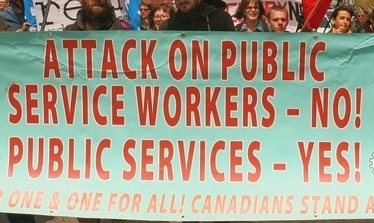 For example, the public
health care enterprises and the
public education enterprises in the provinces and Quebec should
collect their own revenue directly in exchange for the
commodities they produce, which consist mainly of the capacity to
work of educated and healthy workers. The enterprises, both
private and public that buy and consume workers' capacity to work
should pay for the health care and education of the workers,
which they require to perform the work of the companies. The
payment should go directly to the public enterprises producing
the commodity and not through government, which in the present
instance is acting on behalf of the monopolies as a gatekeeper
and block to the proper realization of value. Workers in the
public enterprises of the social and material infrastructure are
quite capable of determining how much value they produce and how
much their enterprises should receive in exchange for the
commodities they produce, and how much more they need to produce
to meet the needs of the economy, people and society.
For example, the public
health care enterprises and the
public education enterprises in the provinces and Quebec should
collect their own revenue directly in exchange for the
commodities they produce, which consist mainly of the capacity to
work of educated and healthy workers. The enterprises, both
private and public that buy and consume workers' capacity to work
should pay for the health care and education of the workers,
which they require to perform the work of the companies. The
payment should go directly to the public enterprises producing
the commodity and not through government, which in the present
instance is acting on behalf of the monopolies as a gatekeeper
and block to the proper realization of value. Workers in the
public enterprises of the social and material infrastructure are
quite capable of determining how much value they produce and how
much their enterprises should receive in exchange for the
commodities they produce, and how much more they need to produce
to meet the needs of the economy, people and society.
Canadians suffer the regular spectacle of Quebec and the provinces arguing with the federal government over how much tax money should be transferred for health care, which is totally irrational. No need exists for the federal or provincial governments to be involved in realizing and distributing the value produced in the public health care and educational enterprises in Quebec and the provinces. Those public enterprises should be responsible to ensure that the value their health care and education workers produce is properly realized in exchange with the enterprises that consume workers' capacity to work, and not just during their working lives but pro-rated on an average life span of a worker. The issue of proper realization in exchange for commodities produced by public enterprises throughout the social and material infrastructure should be put on the table, discussed and implemented. This would remove much of the pressure for taxation and the surrounding obfuscation regarding the economy.
Also, from an objective exchange of the value produced by public enterprise, it becomes obvious that public enterprises are the best and surest way for governments to raise public revenue for increased investments in social programs, public services, the vast scope of the social and material infrastructure necessary for a modern economy and for non-productive activities such as government itself, the police and military.
A public enterprise not only makes a claim on the value it produces for reinvestment back in the public enterprise but also makes some of its produced-value available for a sizeable government claim. The more a sector is de-privatized, the more the claims from owners of social wealth are reduced leaving more value available to meet the needs of governments and the general interests of society. For example in the health care sector, the creation of public pharmaceutical and hospital supply enterprises would eliminate the enormous claims and control of owners of social wealth throughout the health care system. The same could be done in the production of roads, bridges and other commodities of the material infrastructure. This would allow enormous social wealth to be available to solve the economic, political and social problems confronting the country, not to speak of opening up space and possibilities for empowerment of the working class. In this way the actual producers can activate themselves to play their necessary role at the centre of modern life in control of their work, means of production, economy, politics and society.
(To be continued: Learning to look at the entire economy and the value workers produce as a single sheet of steel, a single whole from which claims are made by the three main claimants -- workers in exchange for their capacity to work; governments to serve the general interests of society; and owners of enterprises in exchange for the use of their social property and other wealth.)
October 2 Plebiscite in Colombia
Significance of Plebiscite Results
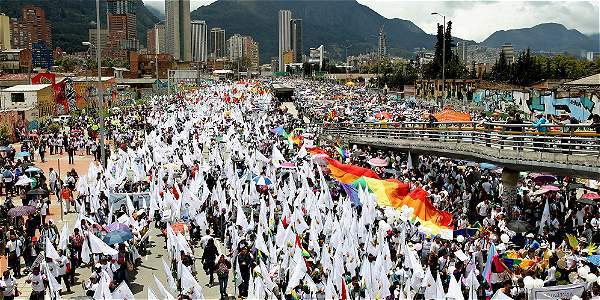
Marches for peace, October 5, 2016.
Since the narrow defeat of the plebiscite on the Peace Agreement on October 2 all kinds of theories and anti-people assertions have been heard to the effect that the Colombian people opted for war or that they cannot be trusted to decide matters of consequence. These are unwarranted conclusions which only serve to stop discussion and thinking about what the vote signified.
For one thing, the ruling circles all sought to make the plebiscite about the Revolutionary Armed Forces of Colombia-People's Army (FARC-EP) instead of the need for social and political solutions rather than military ones to end the war. The No campaign led by ex-president and now Senator Alvaro Uribe Velez flooded the people with claims that the FARC-EP was getting off easy, being paid handsomely to demobilize, was being handed the reins of political power and more -- all of it disinformation meant to force the people to vote based on their opinions of the FARC-EP rather than on the agreement itself and the prospects it opened up for peace.
The government's Yes campaign was all about pacification of the FARC as well. In fact through both their No and the government-led Yes campaigns, the Colombian ruling circles and the imperialists behind them were united in laying the blame for the war on the victims who refused to be victimized and stood up to resist. They all tried to impose their prejudices and self-serving interests on the people to keep them within the confines they wanted for the plebiscite. The independent position of the Colombian working class, peasantry and people clamouring for peace, national reconciliation, for their rights and for an end to state terror was prevented from having its full expression.
It is important to note that the FARC-EP were not able to go around Colombia and campaign but had to do it through their online media platforms. In addition it is clear that low voter turnout along with the big No vote in Medellin and Antioquia Department generally, Uribe's base, became a significant block to a victory for the Yes.
No Campaign
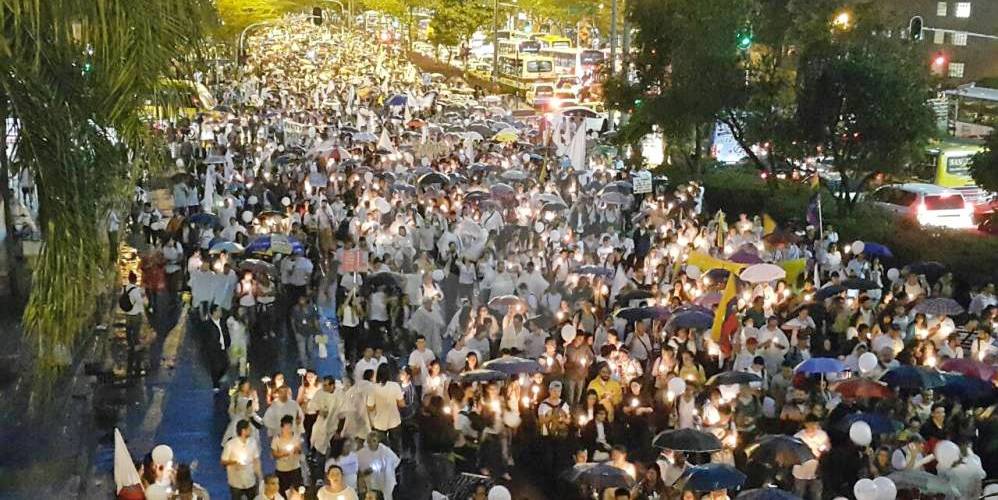
March for peace in Medellín, October 7, 2016.
The No side led by Uribe and his Centro Democrático Party spewed out a barrage of lies and disinformation to equate the Amnesty Law with letting the guerrillas get away with murder, and called for people to vote against "impunity." A longtime proponent of crushing the FARC-EP militarily rather than searching for a political solution to the war, Uribe is himself accused of creating paramilitary death squads when he was Governor of Antioquia from 1995-1997. In fact he is among those who could have to appear before the Special Tribunal for Peace and possibly end up in jail under the transitional justice system that forms part of the Peace Agreement and is charged with investigating state and military officials as well as business people and other civilians suspected of engaging in war crimes and crimes against humanity. With his brother already in jail and being tried for setting up his own death squad, Uribe no doubt fears he will be next. This alone could explain his all-out effort to keep the people from being able to decide in a calm and rational manner. Showing his guilty conscience, Uribe now claims to be for peace, just under different terms than those negotiated by the Santos team, saying what he wants is "peace with justice." The irony that a former president accused of having direct links with paramilitary death squads, not to mention the atrocities carried out by official state forces under his watch as president, now presents himself as the champion of justice and an enemy of impunity cannot be lost on many. During Uribe's presidency poor youth were systematically murdered then dressed up as "guerrillas" by members of the military, including high ranking officers, in order to earn financial and other types of rewards under Uribe's so-called Democratic Security policy.
In order to try to block the adoption of the Peace Agreement, Uribe was quick to position himself as leader of the No campaign and use it to create doubt in the minds of Colombians about the Peace Agreement by portraying it as the product of a hidden agenda of the government and the FARC-EP. This included mobilizing conservative religious sectors to vote No on the basis that the gender perspective incorporated into the Peace Agreement was actually an attempt to destroy the traditional family and gender roles and identities. In departments near the Venezuelan border people were told problems of the type experienced in Venezuela "caused by Castro-Chavismo" would seep into Colombia. All of it was a last ditch effort by Uribe and the interests he represents -- including wealthy business people, landowners and sections of the military allied with the U.S. imperialists -- to kill the agreement that had been reached to shield themselves from its consequences, and for Uribe to resurrect himself as a legitimate political leader instead of a discredited capo of the "para-politics" that has inflicted so much damage on Colombia.
It is worth noting that the plebiscite took place as the killing of political and other activists and threats by paramilitary groups were continuing and even escalating in certain regions of Colombia, no doubt to pour cold water on the people's quest for peace and reconciliation. That would certainly have deterred some from campaigning openly for a Yes vote, or even voting, out of fear of retribution.
Role of U.S.
Coinciding with the September 26 signing of the Peace Agreement, the U.S. State Department affirmed that it was not removing FARC-EP from its terror list. This despite the fact that the European Union had announced it was suspending the FARC-EP from its terror list. This was part of U.S. imperialism's contribution on the eve of the plebiscite to making the vote about people's views of the FARC-EP rather than about the agreement itself, what it represented for the country, and whether it contributed to advancing peace.
The effects of keeping FARC-EP on various terror lists are wide-ranging. Special post-9/11 "anti-terror" laws allow for the wholesale violation of rights, including the ability to travel or seek asylum abroad, not only of those accused of being members of a terrorist group, but all kinds of others deemed guilty by association. This already accounts for thousands of political prisoners in Colombian jails.
The U.S. had earlier announced its support for peace in Colombia in the form of a plan it called Paz Colombia (Peace Colombia), a follow-up to the infamous Plan Colombia launched by Bill Clinton that further militarized the Colombian conflict using a counter-insurgency strategy disguised as a "war on drugs." The new U.S. plan, representing hundreds of millions of dollars earmarked for "security" and "anti-narcotics" as well as other projects, has the same aim of inserting the U.S. into Colombia's internal affairs under the new conditions.
After the plebiscite failed to pass U.S. Assistant Secretary of State John Kirby issued a statement on the results, saying the U.S. "support[ed] President Santos' proposal for unity of effort in support of a broad dialogue as the next step towards achieving a just and lasting peace." The statement left little doubt that the U.S. wants Álvaro Uribe to be a key player in any negotiations going forward when it said: "President Santos, FARC-EP leader Rodrigo Londoño, and opposition leader Álvaro Uribe have all indicated their commitment to achieve peace, and to work together in an inclusive manner to do so." Clearly the U.S. wants Uribe at the table along with Santos and the interests he represents to ensure that whatever the outcome it will favour what the U.S. wants for Colombia's future.
Role of Government Yes Campaign
The Santos government asserted its leadership of the Yes campaign well before the plebiscite was officially called, and placed César Gaviria, former president and former Secretary General of the U.S.-dominated Organization of American States, at the head of its campaign team. This section of the ruling circles allied with Obama, Trudeau and others represents the neo-liberal "third way" in Colombia. Their arguments for peace emphasized the guerrillas disarming and demobilizing and included the self-serving issue of the necessity to create stability to facilitate more foreign investment -- a call for increased takeover of the country's land and resources, a contributing factor to the war in the first place.
When he was president, Gaviria ordered the bombing of the FARC-EP's headquarters, blowing up peace talks that were just about to begin. For his part, Santos was Defence Minister in Uribe's government where he too ordered the bombing of FARC-EP camps to kill members of the Secretariat -- a particularly notorious incident being the U.S.-assisted bombing of a camp just over the Colombian border in Ecuador that killed not only a FARC-EP leader and other members but a number of civilian youth visiting the camp.
Many others who registered their own campaigns in support of a Yes vote did not have the resources or coverage provided to the government campaign in the Santos family-owned El Tiempo group and several other big media outlets. To what extent the working class, labour unions and other representatives of pro-peace forces were able to capture the initiative to get out the vote for peace still has to be determined.
It can be concluded that the government's Yes campaign did not have a clear conscience and sought to ensure that a people's Yes did not take the initiative.
Yes Vote
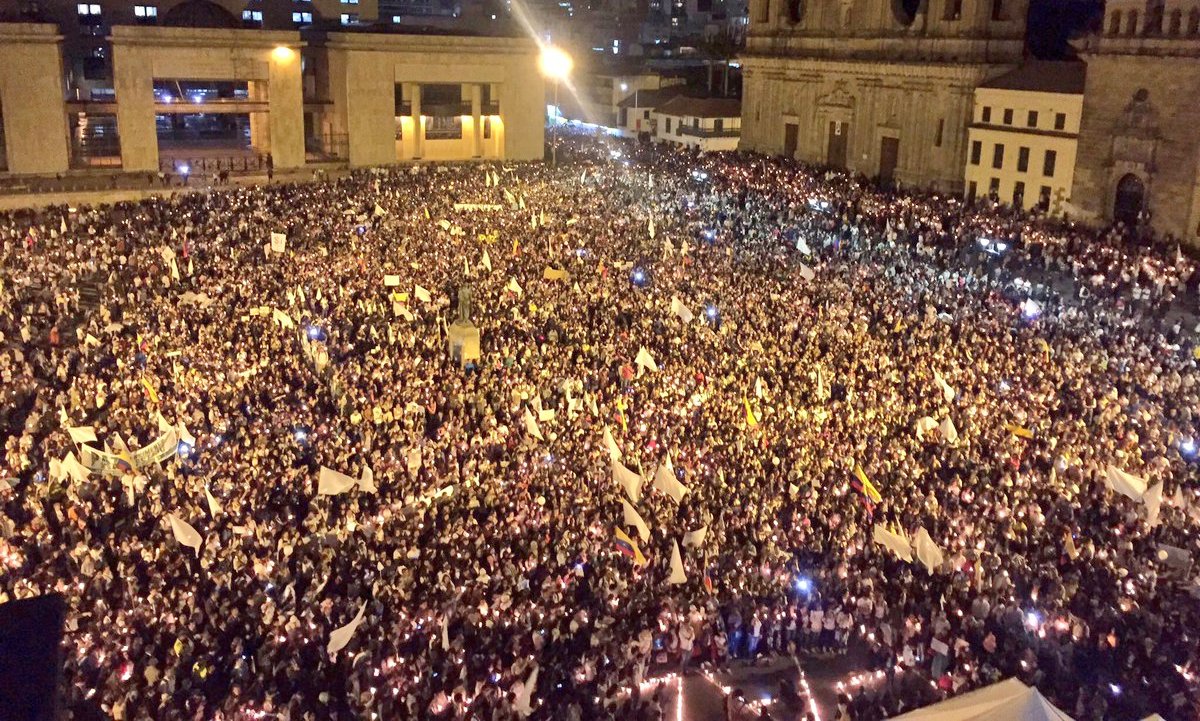
Marches for peace fill streets in Colombia, October 5, 2016.
That despite all this, well over 6 million Colombians voted for the accord and the integration of the FARC-EP into civilian life, shows that the people want a political resolution to the conflict. It is also a rebuke of the U.S., Canadian and other governments that declare the people's resistance to military and paramilitary state violence to be terrorism, all the while presenting state terror -- whether inside Colombia or against other countries -- as being for "peace." Such an inversion of the truth only contributes to more violence and seeks to justify the violation of the rights of a large segment of the population by labeling them terrorists or terrorist sympathizers.
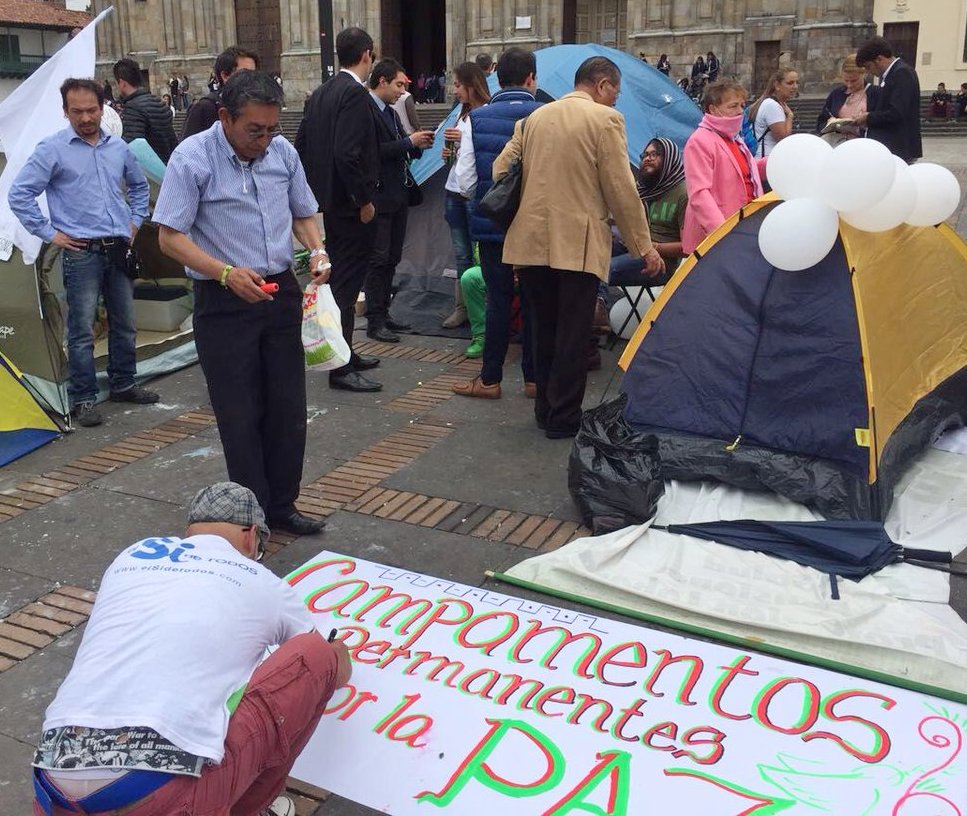 There are already strong
indications that Colombians
are going all out to not permit pro-war forces to destroy the
opportunity to end more than 60 years of violence in Colombia and
return the country to a state of war. On October 5, the streets of
Bogota were filled with tens of thousands of mainly students in a March
for Peace. Similar actions were held in other cities around the country
as well as in New York and cities in a number of other countries. A
National Day of Mobilization for Peace has been called for October 14
by Marcha Patriotica in defence of the Peace Agreement.
There are already strong
indications that Colombians
are going all out to not permit pro-war forces to destroy the
opportunity to end more than 60 years of violence in Colombia and
return the country to a state of war. On October 5, the streets of
Bogota were filled with tens of thousands of mainly students in a March
for Peace. Similar actions were held in other cities around the country
as well as in New York and cities in a number of other countries. A
National Day of Mobilization for Peace has been called for October 14
by Marcha Patriotica in defence of the Peace Agreement.
Canadians can also make their contribution to the Colombian peace process by demanding that Canada remove the FARC-EP from its terrorist list which only contributes to legitimizing military and paramilitary violence and U.S. military interference in Colombia's internal affairs, something that has contributed to extending the war and its disastrous effects.
Demands for Constituent Assembly Grow
One of the results of the plebiscite and the stalemate to which it has given rise is the growing demand for a National Constituent Assembly so the people themselves can sort out how to proceed and determine what changes must be made to the country's constitution.
Right up until the last stages of the negotiations in Havana, the FARC-EP insisted on the need for a constituent assembly after a peace agreement had been reached so the Colombian people would have at their disposal a profound process in which the people from all sectors of society participate in setting the agenda and incorporating what was agreed into the country's fundamental law.
 The FARC-EP felt this would
have prevented the
situation from becoming a battle between factions of the ruling elite
similar to what takes place in an election campaign, diverting
attention from what was at stake for the country's future. But that
option was never agreed to by the government which wanted a vote of the
kind that ultimately was held to simply rubber stamp whatever deal was
reached. This was the case even though the president had full powers to
implement a peace accord without seeking approval from Congress or the
Colombian people through a vote. In the end the FARC-EP
agreed to abide by whatever the Constitutional Court ruled, aware that
in Colombia's constitution, peace is "a right and a mandatory duty" and
not something that can be undermined legally by a negative vote in a
plebiscite. Even though the holding of the vote was understood to be a
means for conferring political legitimacy on what had been agreed (or
not) as opposed to a legally binding mechanism, the Constitutional
Court made passing of the Amnesty Law in particular contingent on a
successful Yes vote in the plebiscite.
The FARC-EP felt this would
have prevented the
situation from becoming a battle between factions of the ruling elite
similar to what takes place in an election campaign, diverting
attention from what was at stake for the country's future. But that
option was never agreed to by the government which wanted a vote of the
kind that ultimately was held to simply rubber stamp whatever deal was
reached. This was the case even though the president had full powers to
implement a peace accord without seeking approval from Congress or the
Colombian people through a vote. In the end the FARC-EP
agreed to abide by whatever the Constitutional Court ruled, aware that
in Colombia's constitution, peace is "a right and a mandatory duty" and
not something that can be undermined legally by a negative vote in a
plebiscite. Even though the holding of the vote was understood to be a
means for conferring political legitimacy on what had been agreed (or
not) as opposed to a legally binding mechanism, the Constitutional
Court made passing of the Amnesty Law in particular contingent on a
successful Yes vote in the plebiscite.
Most of the country's progressive forces joined the FARC-EP in calling for a National Constituent Assembly and continue to do so as a means to consolidate the gains of the peace process, making it still the order of the day.
The responsibility for ensuring the war is stopped and
the door opened to a stable and lasting peace more than ever must be
seen as belonging to the Colombian people and other peace-loving
peoples of the world and their organized anti-war movements. Any
illusions that the impasse will be ended and the way forward for peace
charted by relying on Colombia's ruling circles or the likes of the
U.S. under an Obama or Clinton should be laid to rest. Canadians should
stand with the Colombian people in calling for an end to the use of
force to settle conflicts of a political and social nature and to the
imperialist fomenting of war in the name of "peace" and "justice."
Information on the Results

The October 2 plebiscite in which Colombians were asked to approve the Peace Agreement reached between the Government of Colombia and the Revolutionary Armed Forces of Colombia-People's Army (FARC-EP) resulted in a narrow win for the "No" of fewer than 54,000 votes or 50.21 per cent No to 49.78 per cent Yes.
Final Vote Count
No - 6,431,376
Yes - 6,377,482
Spoiled ballots - 170,946
Unmarked Ballots - 86,243
The result came as a surprise to many as polls reported in the media had all along predicted an easy win for the Yes.
Turnout
Polls opened at 8 am and closed at 4 pm, standard practice for elections in Colombia. Only 37 per cent of registered voters took part, representing an abstention rate of 63 per cent, reported to be lower than the participation rate in any national elections held in the last 22 years. However the threshold established by the Constitutional Court in order for the plebiscite to pass in the event of a Yes win -- at least 4.5 million votes cast for Yes -- was easily surpassed.
Only 18.4 per cent of registered voters cast a No vote, which translates to a much smaller percentage still of the country's potentially eligible electors. The situation was exacerbated by the fact that the National Civil Registry did not provide for new voter registrations for the plebiscite or updating of the rolls to reflect citizens who had moved since the previous election. Young first-time voters and those living abroad who had not previously registered at a Colombian Consulate to vote outside the country, were thereby excluded.
Turnout was particularly low on the Atlantic coast,
notably in the La Guajira, Atlántico and Bolívar
departments, which registered significant majority Yes votes. These
areas were suffering the effects of Hurricane Matthew at the time of
the vote. The Colombian Electoral Observation Mission said that
potentially four million people could not vote in those regions because
of the extreme weather. In the city of Santa Marta and six other
municipalities the Risk Management Council had to declare a public
disaster that affected tens of thousands of residents.
The Electoral Observation Mission noted that only 61 per cent of voting stations had the required personnel in place to accept votes when they opened.
Regional Trends
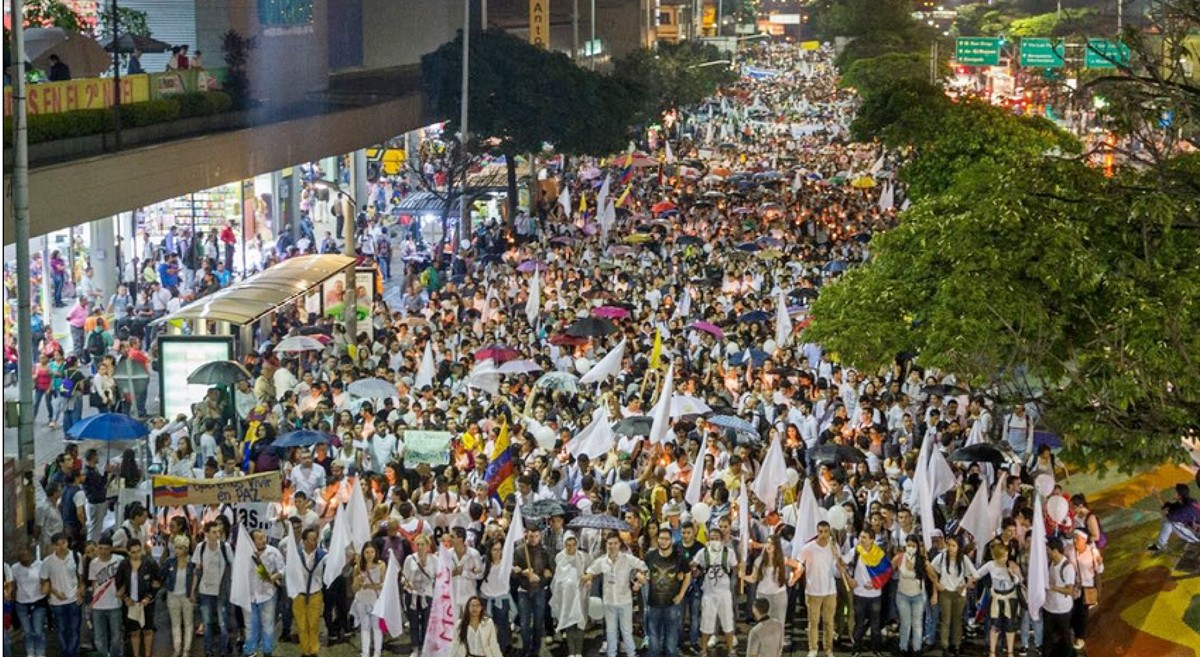
Mass demonstrations for peace in Medellín, October 7, 2016.
Areas whose residents have been most affected by the war voted decisively for peace. As well the majority in the capital city of Bogota and two other large cities, Cali and Barranquilla voted Yes.
In Medellín, the country's second-largest city and the capital of the Department of Antioquia, as well as several other departmental capitals, the majority voted No. Medellín is the base of pro-war ex-president Álvaro Uribe Vélez whose Centro Democrático party headed up the No campaign nationally. It is also reported that the former right hand man of drug lord Pablo Escobar led the campaign for the No side in Medellín. Escobar's henchman has admitted to having carried out hundreds of killings and ordering thousands more for the Medellín Cartel and participating in the systematic extermination of members of the Unión Patriótica party, for which he spent 22 years in prison.
Vote Abroad
Of the 82,721 Colombians who voted abroad (just under
14 per cent of the 600,000 registered) 54.02 per cent voted Yes and
45.97 per
cent No. Only in the U.S., Paraguay and the United Arab Emirates did
the No vote win. Canada had the fifth largest number of registered
voters after the U.S., Venezuela, Spain and Ecuador (17,355 of a
reported 100,000 Colombians resident in Canada.)
Outcome
The bilateral ceasefire remains in place as confirmed by the government and FARC-EP. However on October 5 President Santos announced the government will only maintain its ceasefire until October 31. The bilateral ceasefire is what put a halt to the open war, creating conditions to build peace in the country based on dialogue and the adoption of social and political solutions to the problems that gave rise to the conflict.
Importantly, however, the No vote has blocked President Santos from sending the Amnesty Law contained in the Peace Agreement to the Colombian Congress for expedited passage. The country's Constitutional Court, which authorized the October 2 vote, made sending this law to Congress contingent on successful passage of the plebiscite.
The FARC-EP had said on different occasions that their movement to the temporary "normalization" zones and disarmament required the Amnesty Law to be in place. The No vote leaves this situation in limbo.[1]
Colombian President Awarded Nobel Peace Prize
On October 7 Colombian President Juan Manuel Santos was
awarded the Nobel Peace Prize. Kaci Kullmann Five, chair of the
Norwegian Nobel committee, gave the reasons for choosing Santos as the
winner of this year's peace prize:
"President Santos initiated the negotiations that culminated in the
peace accord between the Colombian government and the FARC guerrillas,
and he has consistently sought to move the peace process forward, well
knowing that the accord was controversial. He was instrumental in
ensuring that Colombian voters were able to voice their opinion
concerning the accord in a referendum. The outcome of the vote was not
what President Santos wanted. A narrow majority of the over 13 million
Colombians who cast their ballots said no to the accord.
"This result has created great uncertainty as to the future of
Colombia. There is a real danger that the peace process will come to a
halt and that civil war will flare up again. This makes it even more
important that the parties headed by President Santos and FARC
guerrilla leader Rodrigo Londoño continue to respect the
ceasefire."
She said, "The award should also be seen as a tribute to the
Colombian people who, despite great hardships and abuses, have not
given up hope of a just peace, and to all the parties who have
contributed to this peace process. This tribute is paid not least to
the representatives of the countless victims of the civil war.
Kullmann Five did not respond to questions from the media gathered
about
why FARC-EP leader Londoño, also known as Timochenko, was not
also awarded the prize. Timochenko responded to the prize announcement
on Twitter saying, "The only award we want is peace with social justice
for Colombia without paramilitarism, without retaliation or lies."
Note
1. See TML Weekly, September 24, 2016 for information on the process for adoption of the Peace Agreement.(El Espectador, El Tiempo, TeleSUR, Toronto Star. Photos: El Tiempo, Radio Santa Fe, Xinhua, el Colombiano, D. Falonso, C. Doval)
Voter Manipulation Exposed
Since the defeat of the October 2 plebiscite to approve the Peace Agreement reached in Havana between the Government of Colombia and the Revolutionary Armed Forces of Colombia (FARC-EP), news is emerging of the organized manipulation of the vote through sophisticated targeting of different sections of the Colombian people to smash public opinion that favoured a peaceful resolution of the conflict.
Juan Carlos Vélez, former mayoral candidate in Medellín, manager and bagman for former Colombian President Álvaro Uribe's Centro Democrático Party's No campaign in the plebiscite, explained that the No campaign "discovered the viral power of social networks." He gave the example of a campaign stop in Apartadó, Antioquia, where a local councillor gave him a picture of President Santos and [FARC-EP leader] Timochenko with the message "Why would he give money to the guerrillas if the country is in the hole?" He said, "I posted it on my Facebook page and [by October 1] it had 130,000 shares with a reach of six million people."
He further revealed that "strategists" from Panama and Brazil said the No campaign's strategy should be to forget about explaining the accords and concentrate on messages that will elicit indignation -- a clear indication that the issue was to get people to vote based on being incited rather than informed.
He explained how segmenting and micro-targeting of the population was used to get the desired results. In radio advertising for the "middle and upper strata we focused on saying No to impunity and eligibility [for amnesties and alternative sentencing under the system of alternative justice], and tax reforms, he said. With the lower strata radio stations 'we focused on the subsidies' [for the guerrillas to re-integrate into civilian life]. For each segment of the population in each respective region we used their accents [sic]. On the coast we individualized the message that [if the referendum passed] we would become like Venezuela." [Vélez is quoted as using the word "la Costa" which means on the coast, but it is likely that he is referring to the border regions with Venezuela -- TML Ed Note.]
Vélez informed that the No side received financing from "mainly 30 companies and 30 individuals" with Ardila Lülle Organization, Grupo Bolívar, Grupo Uribe, Codiscos, and Corbeta[1] being the top five contributing companies. It is not clear if the 30 individuals have controlling interests in the 30 companies and thus used their individual wealth and control over various sections of the economy to influence the vote.
When asked directly why their campaign twisted the truth, Vélez stated only that this was the same thing done by the Yes side.
Immediately following Vélez's revelations, Centro Democrático issued a statement refuting their campaign manager's statements, particularly those about foreign strategists' involvement. Their statement indicated only that the campaign did not "hire foreign strategists." These are weasel words to hide the role played by various experts in the "dark arts" of elector manipulation to ensure a certain outcome, in this case a No victory.[2]
The Centro Democrático put its dirty campaign this way: "Party spokespeople, Congress people and corporate entities developed a strategy of direct communication with Colombians, reasonably explaining the implications of the Havana Accords," the statement said.
It went on to say that the No side "did not resort to lies and twisting of messages" and that the party utilized arguments so that people would "vote their conscience over the great harm that the country would have incurred if these accords had been approved and automatically become part of the Constitution."
Meanwhile Edgar Castaño, President of the Evangelical Confederation of Colombia said that of its congregations with their 10 million members, possibly 4 million voted, half of whom he thought would have voted No. He said they believe, like he does, that the agreement as written threatens his notion of the family. It goes against some principles of the evangelicals, he said, For example when you give equal value to LGBTI groups and women. He was one of fourteen representatives of Christian churches who were received on October 6 at a meeting with Colombian President Juan Manuel Santos in the wake of the plebiscite. The only other group invited to meet with him that day were representatives of companies.
Note
1. Ardila Lülle Organization is headed by Carlos Arturo Ardila Lülle whose net worth is estimated at over US$2 billion. The conglomerate most notably controls Colombian radio and television monopoly Radio Cadena National (RCN) TV.
Uribe Group -- There are a number of Uribe groups. It is not known if this one is linked to former Colombian President Alvaro Uribe.
Codiscos -- A record label from Medellin.
Corbeta -- A large retail chain in Colombia.
2. Similar forces were brought to Canada by political parties to act as strategists on how to win the last federal election by doing their maximum to divide the people using sophisticated techniques combined with powerful elector databases the parties have built using Elections Canada's List of Electors. The Conservatives engaged Australian political strategist Lynton Crosby for the 2015 federal election to try to manipulate the vote, while the Liberals appeared to have their own "in-house" experts.
(La Republica, BBC Mundo)
Meeting of National Government and
FARC-EP Delegations

The Colombian National Government and the FARC-EP [Revolutionary Armed Forces of Colombia-Peoples Army] delegations, after meeting in Havana with the guarantor countries and the Head of the Special Mission of the United Nations in Colombia, Jean Arnault, want to inform public opinion that:
1. After almost four years of intense talks, we concluded on the 24th of August the Final Agreement for the Termination of the Armed Conflict and the Construction of a Stable and Lasting Peace, to which we are committed. We believe it contains the necessary reforms and measures to lay the foundations of peace and ensure the end of the armed conflict.
We recognize, however, that the majority of those who participated in the Plebiscite of October 2 voted against, albeit by a narrow margin. Within the framework of the presidential powers under the Constitution, it is appropriate that we continue listening, through a quick and efficient process, to different sectors of society, to understand their concerns and promptly define a solution according to the statement from the Constitutional Court C-376 2016. The proposals for adjustments and clarifications resulting from this process will be discussed between the National Government and the FARC-EP to assure guarantees for everybody.
2. We reiterate the commitment of the President of the Republic and the Comandante of the FARC-EP to keep the Final and Bilateral Ceasefire and Cessation of Hostilities decreed on August 29, and the monitoring and verification by the tripartite mechanism; as well as the guarantees of security and protection for communities in their territories, as defined in the Protocol by the parties.
To strengthen this Ceasefire we have agreed to a protocol aimed at preventing any incidents in pre-grouping areas in the defined quadrants and ensure a climate of security and tranquility with the full implementation of all rules governing the Final and Bilateral Ceasefire and Cessation of Hostilities.
The Tripartite Monitoring and Verification Mechanism, with the participation of the Government and the FARC-EP and coordinated by the mission of the United Nations will be responsible for monitoring and verifying compliance with the protocol, in particular compliance with the rules governing the Ceasefire.
3. To that end, we request the Secretary-General of the United Nations, and through him, the Security Council, to authorize the Mission of the United Nations in Colombia to exercise the functions of monitoring, verification, resolution of conflicts, recommendations, reporting and coordination of the Verification and Monitoring Mechanism envisaged in Resolution 2226 (2016) referring to mentioned Protocol.
Also, we invite the countries that are contributing to the Mission with unarmed observers, to continue deploying their men and women, who will continue to have all the necessary safety guarantees.
4. In parallel, we will continue making progress in the implementation of confidence-building measures of a humanitarian nature, such as the search for missing persons, pilot plans for humanitarian demining, voluntary substitution of illicitly used crops, commitments regarding the departure of minors from the camps and regarding the situation of persons deprived of liberty.
5. The delegations thank the International Committee of the Red Cross for their continued support, Chile and Venezuela for their accompaniment and especially Cuba and Norway for their hard and dedicated work of support for the construction of peace agreements for Colombia, their constant contributions to the search for solutions in difficult times and their readiness to continue supporting the peace process.
(Havana, Cuba, October 7, 2016)
What Is Canada Up to in Colombia?

Marches for peace, October 5, 2016. (Zanti Camargo)
The plan to have Canada and Mexico operate in the interests of U.S.imperialism in Colombia was articulated by U.S. Secetary of State John Kerry at the North American Leaders' Summit last June. There Kerry stated publicly that the three heads of state worked out together how they would involve themselves in Colombia -- right as peace negotiations were taking place. "[W]e discussed our support for the Colombian peace process -- our efforts, all together, to end the longest-running civil conflict in the region," he said.
Since that time the Canadian government has made a flurry of announcements, indicating it is implementing whatever decisions were made at the Summit for the role it would play in Colombia as part of what the U.S. calls Peace Colombia, its follow-up to the militarized Plan Colombia that has been in operation since 2000.
Defence Minister Harjit Sajjan's office has recently confirmed that Colombia is one of the countries to which the Liberals are considering the deployment of Canadian soldiers in what it calls peace operations. In the most arrogant fashion, other countries' internal conflicts are made the target of the Canadian government as if it has a right to interfere and that the only issue is for it to choose who will benefit from that interference.
When Colombia's Ambassador to Canada Nicolas Lloreda was asked about potential Canadian involvement, presumably in an international observer mission to monitor the ceasefire and other provisions of the Peace Agreement as they take effect, he said any decision would be made by the UN. "We have an excellent relationship with Canada in every aspect," he said. "But we've decided that the best thing is to go through the United Nations at this point and it should be up to the UN to decide who has the capability and which country really brings something positive to the table."
This gives a sense of how Canada is seeking to impose
itself on Colombia via various formal and informal means. That the
Colombian ambassador had to publicly indicate that it would be the UN
that decides, not his government, in matters related to post-conflict
peacekeeping reveals that Canada is likely pushing for Colombia to go
outside of whatever process has been established to oversee the
bilateral ceasefire between the government and the Revolutionary Armed
Forces of Colombia-People's Army (FARC-EP). One issue is that it has
mainly been countries of the Community of Latin American and Caribbean
States (CELAC) that have been given this role. Canada does not belong
to CELAC nor to the Union of South American Nations (UNASUR), which
were both established as alternatives to the U.S.-dominated
Organization of American States (OAS), that is notorious for meddling
in the affairs of Latin America and the Caribbean and of which Canada
is a member.
 Meanwhile on September 20,
the government pledged an additional $33.8 million towards "de-mining
and reconstruction efforts in [Colombia]." The day after, Foreign
Affairs Minister Stéphane Dion committed $25 million to UN-led
conflict mediation, negotiation and reconstruction projects in
Colombia. Then on September 26 while in Cartagena, Colombia, attending
the signing of the Peace Agreement between the Government of Colombia
and the FARC-EP, Dion announced a further $21 million over three years
for "peacebuilding." It was described as building on a $57.4 million
allocation to "development assistance initiatives to help
conflict-affected populations," made by Minister of International
Development and La Francophonie Marie-Claude Bibeau in July.
Meanwhile on September 20,
the government pledged an additional $33.8 million towards "de-mining
and reconstruction efforts in [Colombia]." The day after, Foreign
Affairs Minister Stéphane Dion committed $25 million to UN-led
conflict mediation, negotiation and reconstruction projects in
Colombia. Then on September 26 while in Cartagena, Colombia, attending
the signing of the Peace Agreement between the Government of Colombia
and the FARC-EP, Dion announced a further $21 million over three years
for "peacebuilding." It was described as building on a $57.4 million
allocation to "development assistance initiatives to help
conflict-affected populations," made by Minister of International
Development and La Francophonie Marie-Claude Bibeau in July.
Dion tweeted that his visit also included a "candid conversation with Colombian women to learn about their role in peace negotiations and peacebuilding" and a visit to a centre where former "child combatants" were receiving training for reintegration into civilian life.
Speaking to a meeting on Demining Initiatives for Colombia organized by the United States and Norway on the sidelines of the 71st UN General Assembly, Dion listed a number of demining projects Canada was involved in. He said Canada would be "an active partner in the Global Demining Initiative for Colombia launched last year by Norway and the United States and had recently committed $12.5 million" in funding for HALO Trust's landmine surveys and clearance operations in up to 10 municipalities.
He also said Canada would contribute another $1.3 million to the OAS "for logistical support in demining action" and that some of its $20 million contribution to the UN Multi-Partner Trust Fund for post-conflict programming in Colombia would also go towards demining.
Meanwhile the Canadian Embassy in Colombia's
twitter account has lately been full of photos and tweets about
different projects Canada is financing and a visit to the country in
September by the Standing Committee on Foreign Affairs and
International Development. Included in the projects mentioned are a
number of "peacebuilding" initiatives with children and women, some
research projects and a PSOP [Peace and Stabilization Operations
Program] to "help rural & urban police reform in support of [the]
peace agreement."
Also featured was Canada's collaboration with an OAS
Mission in Support of the Peace Process (MAPP) recently approved by the
Colombian government to "monitor the challenges, risks and threats to
peace in Colombia." The mission is to have an active and permanent
presence in territories the FARC-EP are expected to vacate and where
the National Liberation Army (ELN) and other armed organizations have a
presence, to "monitor the security conditions and impacts on
communities." It will also "monitor the development of social conflicts
that represent challenges to the consolidation of peace and will
continue engaging in tasks related to the rights of social leaders,
human rights defenders, peasants reclaiming their lands and subject to
collective reparations, indigenous and Afro-Colombian peoples among
others."
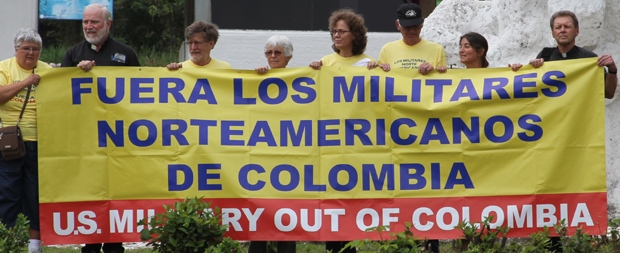
Can there be any doubt what this intrusion of the OAS to "monitor" what is taking place in areas where the FARC-EP and other insurgent groups have for years operated is really about? Or any doubt that Canada is playing the role assigned to it by the U.S. as part of its dubious "Peace Colombia," the follow-up to 16 years of fuelling war with its Plan Colombia?
Any contribution to peace in Colombia, especially in "areas and populations most affected by the conflict," which is where Canada says it wants to be involved, would require strict neutrality to favour peace. How can Canada -- which has one of the parties to the conflict on its terror list and works hand in glove with the U.S., a direct protagonist in the war from the very beginning -- be considered credible in this regard? Not to mention its economic interests in this resource-rich country, especially in mining and other extractive industries. Just as in Syria where Canada's "contribution" to reaching a political settlement involves working with the anti-Syrian government side and being part of the U.S. coalition waging a war for regime change in the country, it would be a stretch to expect its involvement in Colombia to be a genuine factor for peace, dialogue and political solutions.
Which raises the question: What is Canada really up to?
Website: www.cpcml.ca Email: editor@cpcml.ca


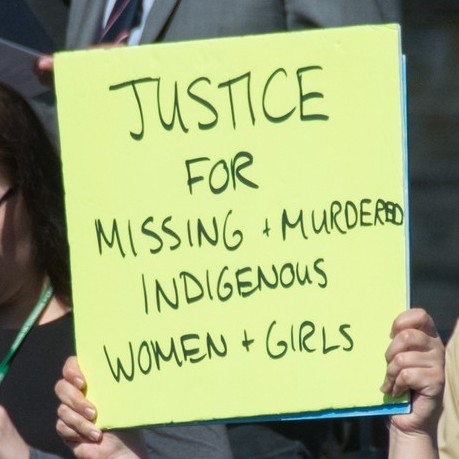 The Trudeau government came
to power with an electoral platform of promises to take immediate
action to enact all 94 recommendations of the Truth and Reconciliation
Commission, starting with the UN Declaration on the Rights of
Indigenous Peoples; to "have a renewed, nation-to-nation relationship
with Indigenous Peoples, based on recognition, rights, respect,
co-operation, and partnership;" and to "immediately lift the two per
cent cap on funding for First Nations programs." After almost one year
of the new government, the people are facing business as usual on all
of these fronts and in some cases even more nefarious attacks on their
rights under the guise of a "renewed relationship" with the federal
government.[
The Trudeau government came
to power with an electoral platform of promises to take immediate
action to enact all 94 recommendations of the Truth and Reconciliation
Commission, starting with the UN Declaration on the Rights of
Indigenous Peoples; to "have a renewed, nation-to-nation relationship
with Indigenous Peoples, based on recognition, rights, respect,
co-operation, and partnership;" and to "immediately lift the two per
cent cap on funding for First Nations programs." After almost one year
of the new government, the people are facing business as usual on all
of these fronts and in some cases even more nefarious attacks on their
rights under the guise of a "renewed relationship" with the federal
government.[ In Ottawa, events began with
a Families of Sisters in Spirit Press Conference, followed by a vigil
on Parliament Hill and then a feast in support of families of missing
and murdered women. A poignant ceremony took place to commemorate the
loss of Annie Pootoogook, an acclaimed Inuit artist who died under
suspicious circumstances in Ottawa on September 19. As they paid
tribute to Annie, her friends and family members denounced the racism
of the police investigation which tried to claim there was nothing
suspicious about her death, following which an officer was discovered
to have posted racist comments about her death online. The vigil at
Parliament Hill was also addressed by Prime Minister Justin Trudeau and
three other ministers. They arrived after the other speakers had
finished and spoke in a manner which people present said dismissed the
serious issues raised by family members. Many remarked that the way
they spoke confirmed what the family members themselves said -- it was
more words to cover up the lack of deeds.
In Ottawa, events began with
a Families of Sisters in Spirit Press Conference, followed by a vigil
on Parliament Hill and then a feast in support of families of missing
and murdered women. A poignant ceremony took place to commemorate the
loss of Annie Pootoogook, an acclaimed Inuit artist who died under
suspicious circumstances in Ottawa on September 19. As they paid
tribute to Annie, her friends and family members denounced the racism
of the police investigation which tried to claim there was nothing
suspicious about her death, following which an officer was discovered
to have posted racist comments about her death online. The vigil at
Parliament Hill was also addressed by Prime Minister Justin Trudeau and
three other ministers. They arrived after the other speakers had
finished and spoke in a manner which people present said dismissed the
serious issues raised by family members. Many remarked that the way
they spoke confirmed what the family members themselves said -- it was
more words to cover up the lack of deeds. 
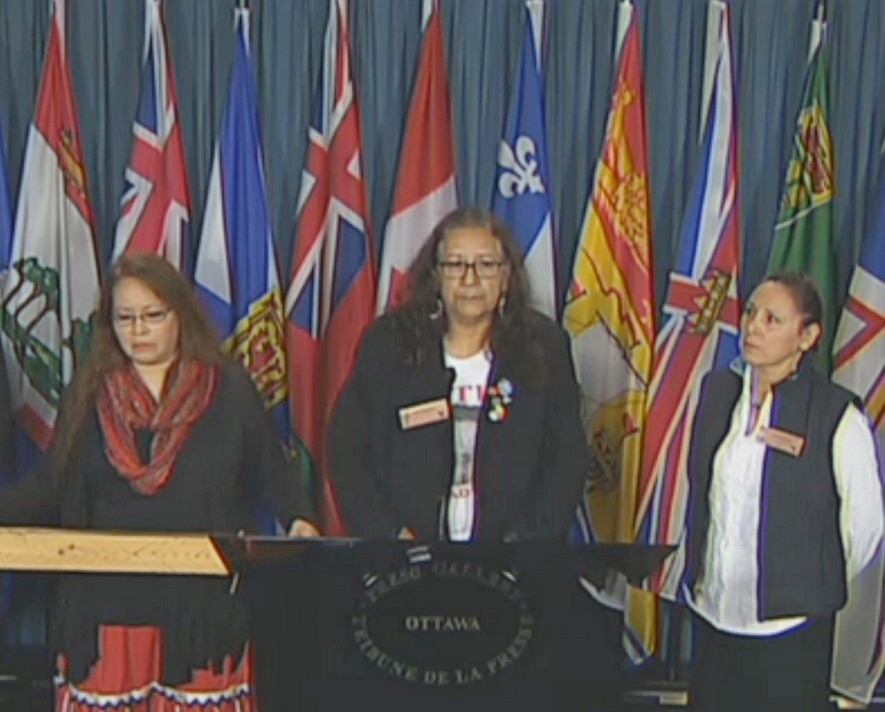 At the press conference,
Bridget Tolley of the Algonquin Kitigan Zibi First Nation, whose mother
Gladys Tolley was killed in a police hit-and-run, expressed a concern
held by many families, that examining the role of police is not part of
the official terms of reference of the National Inquiry. Tolley noted
that after her mother was
killed police blamed the victim, saying she was drunk. Tolley is
calling for an independent investigation and spoke out against
the fact that the National Inquiry will not be dealing with the
cases brought forward by families. It is "not right for an
Inquiry to give the information that we give them back to the
people we are complaining about, the police," she added. "We have
asked over and over again for help for women when they go
missing, we have asked for help for families, there's still
nothing. In the past 15 years I've been here, there's been no
change. As a matter of fact, I think it's getting worse. But we
want justice. We don't want to be here anymore. We shouldn't have
to be here. We shouldn't have to beg for justice. Our families
deserve it, our loved ones deserve it," Tolley said.
At the press conference,
Bridget Tolley of the Algonquin Kitigan Zibi First Nation, whose mother
Gladys Tolley was killed in a police hit-and-run, expressed a concern
held by many families, that examining the role of police is not part of
the official terms of reference of the National Inquiry. Tolley noted
that after her mother was
killed police blamed the victim, saying she was drunk. Tolley is
calling for an independent investigation and spoke out against
the fact that the National Inquiry will not be dealing with the
cases brought forward by families. It is "not right for an
Inquiry to give the information that we give them back to the
people we are complaining about, the police," she added. "We have
asked over and over again for help for women when they go
missing, we have asked for help for families, there's still
nothing. In the past 15 years I've been here, there's been no
change. As a matter of fact, I think it's getting worse. But we
want justice. We don't want to be here anymore. We shouldn't have
to be here. We shouldn't have to beg for justice. Our families
deserve it, our loved ones deserve it," Tolley said. Beverly Jacobs, a Mohawk
woman from Six Nations Grand River Territory and former President of
the Native Women's Association of Canada (NWAC) also spoke on the
significance of the land, decision-making over the land and the ongoing
colonial injustice in the lives of Indigenous women. Jacobs' cousin
went missing and was found murdered in 2008 during her tenure as NWAC
President. "I have a message for Trudeau, I have a message for
Carolyn Bennett, that they need to address the land issues," she said.
"They
need to address the direct connection and also understand the direct
connection of our women to our lands and territories, and that it is
our women who are the front line and who are doing the work. They are
the ones being targeted. Our women are being targeted because we are
the ones who bring nationhood. We are still in a colonial state, we are
still in a police state, and so there needs to be, talking about
'reconciliation,' a real reconciliation," she said.
Beverly Jacobs, a Mohawk
woman from Six Nations Grand River Territory and former President of
the Native Women's Association of Canada (NWAC) also spoke on the
significance of the land, decision-making over the land and the ongoing
colonial injustice in the lives of Indigenous women. Jacobs' cousin
went missing and was found murdered in 2008 during her tenure as NWAC
President. "I have a message for Trudeau, I have a message for
Carolyn Bennett, that they need to address the land issues," she said.
"They
need to address the direct connection and also understand the direct
connection of our women to our lands and territories, and that it is
our women who are the front line and who are doing the work. They are
the ones being targeted. Our women are being targeted because we are
the ones who bring nationhood. We are still in a colonial state, we are
still in a police state, and so there needs to be, talking about
'reconciliation,' a real reconciliation," she said. The vigil at Parliament
Hill was opened with a speech and honour song from Jocelyn
Wabano-Iahtail, a member of the Cree nation from Attawapiskat who now
lives in Ottawa and is well-known for speaking out for just causes.
Jocelyn emphasized that the government cannot use what it calls
nation-to-nation relations to make deals behind the backs of the people
and that she and other victims, families and communities are determined
to exercise leadership and represent themselves. She reiterated that an
inquiry into missing and murdered women must be holistic and based on
Indigenous ways. "Canada sells itself as being the number one country
in the world," she noted, and yet Indigenous women suffer such
brutality. "We are asking not to be displaced physically, mentally,
emotionally, spiritually," she said. Jocelyn also took part in an
unveiling ceremony for a Memorial Red Ribbon Dress to honour the life
of her daughter Nitayheh of the Ininew Eeyou Cree and Mi'kmaq Nations
who she lost on November 13, 2001.
The vigil at Parliament
Hill was opened with a speech and honour song from Jocelyn
Wabano-Iahtail, a member of the Cree nation from Attawapiskat who now
lives in Ottawa and is well-known for speaking out for just causes.
Jocelyn emphasized that the government cannot use what it calls
nation-to-nation relations to make deals behind the backs of the people
and that she and other victims, families and communities are determined
to exercise leadership and represent themselves. She reiterated that an
inquiry into missing and murdered women must be holistic and based on
Indigenous ways. "Canada sells itself as being the number one country
in the world," she noted, and yet Indigenous women suffer such
brutality. "We are asking not to be displaced physically, mentally,
emotionally, spiritually," she said. Jocelyn also took part in an
unveiling ceremony for a Memorial Red Ribbon Dress to honour the life
of her daughter Nitayheh of the Ininew Eeyou Cree and Mi'kmaq Nations
who she lost on November 13, 2001. "Yet, they re-traumatize us
as families who are living through this nightmare. And I'm tired of
that. I'm tired of hearing our leaders say they're standing with us,
yet when we go to their doors some of those doors are closed on us. But
they're right there for a photo op. And I'm tired; I want justice for
my daughter, for Shannon, for all of these women: our sisters, our
children, our aunts, our grandmothers, our loved ones. We are living
through this, not them -- they need to understand that. Yet they throw
us promises. Well, you know what? We haven't heard anything yet.
Nothing from this Inquiry. They have a few years to hand out a report,
[like] so many of these reports have been done," Odjick said.
"Yet, they re-traumatize us
as families who are living through this nightmare. And I'm tired of
that. I'm tired of hearing our leaders say they're standing with us,
yet when we go to their doors some of those doors are closed on us. But
they're right there for a photo op. And I'm tired; I want justice for
my daughter, for Shannon, for all of these women: our sisters, our
children, our aunts, our grandmothers, our loved ones. We are living
through this, not them -- they need to understand that. Yet they throw
us promises. Well, you know what? We haven't heard anything yet.
Nothing from this Inquiry. They have a few years to hand out a report,
[like] so many of these reports have been done," Odjick said.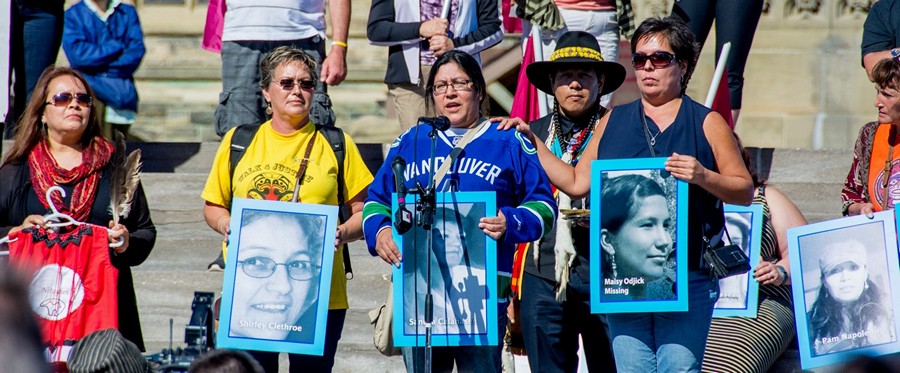
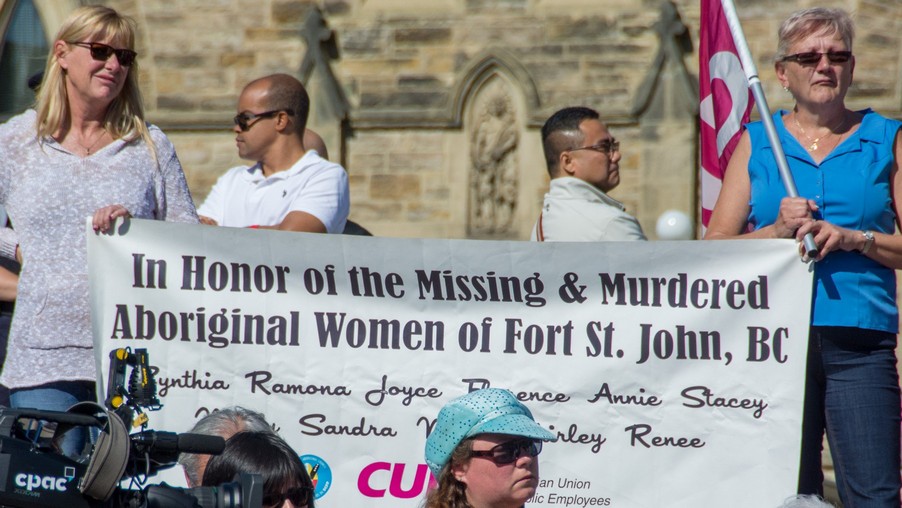





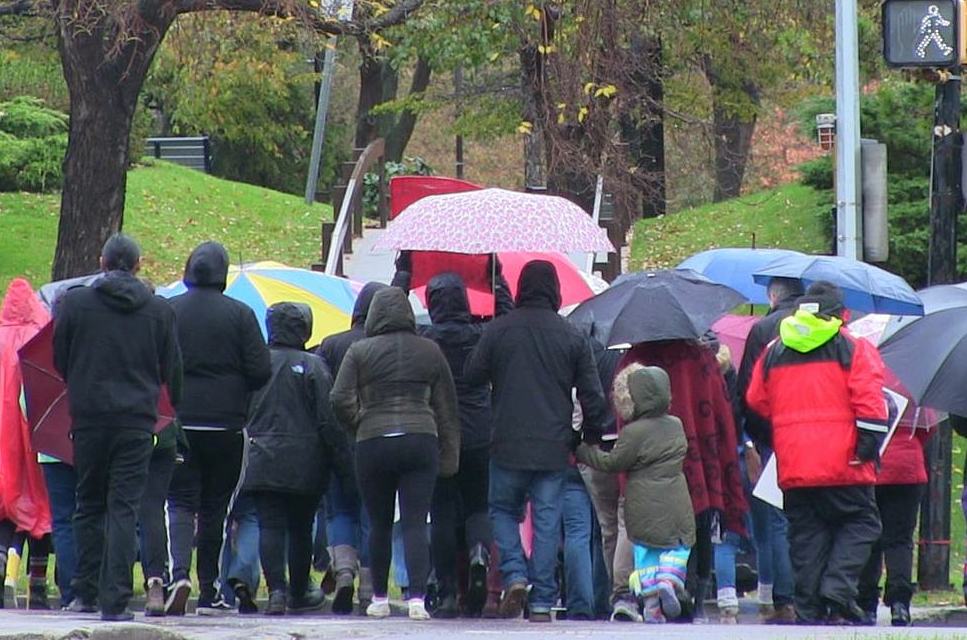
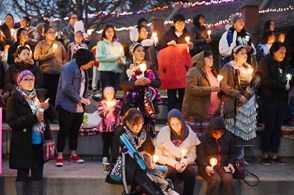

 He stated that, in the
past, the Parliament and its
members
"failed to uphold the values and principles which we're supposed
to defend, failed specifically missing and murdered Indigenous
women and girls, and all others, and we failed in general in
upholding the spirit, the intent of the original relationship
between Indigenous peoples and those who arrived on this land."
It is not clear what the Prime Minister thinks the "spirit" of
the "original relationship" was or who the relationship was
between but it is not a modern relationship based on ending
colonial injustice and recognition of rights or an equal union
between nations enshrined in a modern constitution. The failure
to abide by an "original relationship" is "not something that
we're going to be able to change overnight, or in a week, or in a
month, or in a year," the Prime Minister said. "It is something
we are going to have to commit to work on every day, to fix, to
improve, to build, to repair broken trusts, to give back hope.
It's not something the Prime Minister or government can do on
their own."
He stated that, in the
past, the Parliament and its
members
"failed to uphold the values and principles which we're supposed
to defend, failed specifically missing and murdered Indigenous
women and girls, and all others, and we failed in general in
upholding the spirit, the intent of the original relationship
between Indigenous peoples and those who arrived on this land."
It is not clear what the Prime Minister thinks the "spirit" of
the "original relationship" was or who the relationship was
between but it is not a modern relationship based on ending
colonial injustice and recognition of rights or an equal union
between nations enshrined in a modern constitution. The failure
to abide by an "original relationship" is "not something that
we're going to be able to change overnight, or in a week, or in a
month, or in a year," the Prime Minister said. "It is something
we are going to have to commit to work on every day, to fix, to
improve, to build, to repair broken trusts, to give back hope.
It's not something the Prime Minister or government can do on
their own." At the October 4th Sisters In
Spirit vigils throughout the
country, we heard family members describe their disappointment
and concern about the delays in starting the National Inquiry.
The Native Women's Association of Canada (NWAC) would also like
to express our disappointment and frustration with the lack of
substantial progress in the National Inquiry into Missing and
Murdered Indigenous Women and Girls since its official launch on
August 3rd, 2016.
At the October 4th Sisters In
Spirit vigils throughout the
country, we heard family members describe their disappointment
and concern about the delays in starting the National Inquiry.
The Native Women's Association of Canada (NWAC) would also like
to express our disappointment and frustration with the lack of
substantial progress in the National Inquiry into Missing and
Murdered Indigenous Women and Girls since its official launch on
August 3rd, 2016. Family members, loved ones, and
survivors deserve a
transparent National Inquiry that is capable of delivering
justice and properly honouring the over 1,200 Missing and Murdered
Indigenous Women and Girls in Canada. A transparent National
Inquiry includes easily accessible information regarding office
locations across Canada, readily available contact information to
the Commissioners and their staff, a step-by-step guide on how to
get involved with the Inquiry, a straightforward and coherent
website, and other necessary infrastructure that will ensure the
success of this Inquiry.
Family members, loved ones, and
survivors deserve a
transparent National Inquiry that is capable of delivering
justice and properly honouring the over 1,200 Missing and Murdered
Indigenous Women and Girls in Canada. A transparent National
Inquiry includes easily accessible information regarding office
locations across Canada, readily available contact information to
the Commissioners and their staff, a step-by-step guide on how to
get involved with the Inquiry, a straightforward and coherent
website, and other necessary infrastructure that will ensure the
success of this Inquiry.